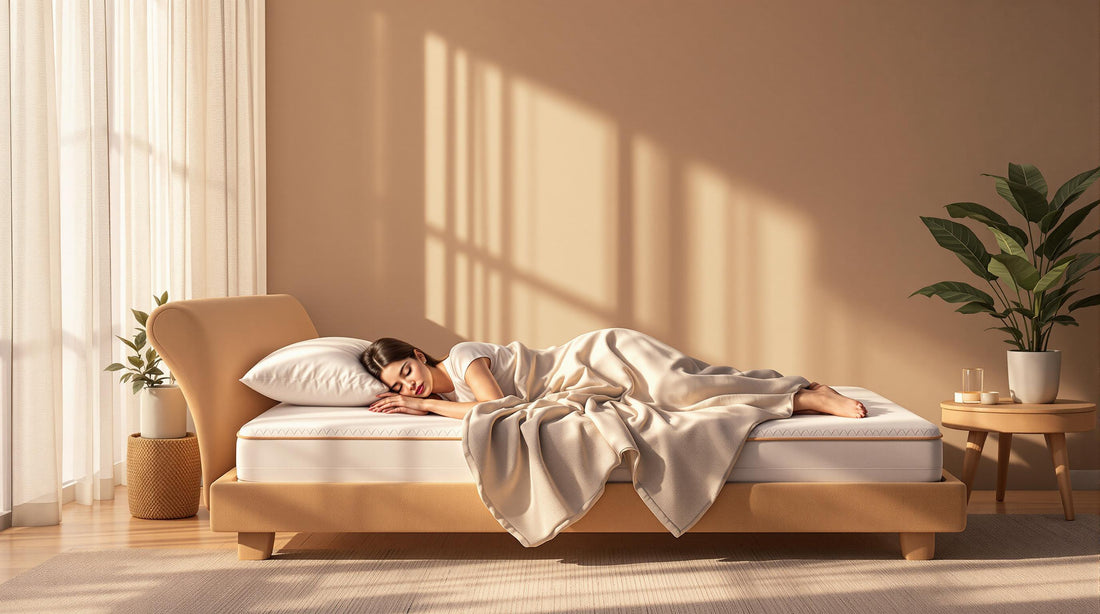Sleeping in the right position can improve comfort, reduce joint pain, and support better breathing. Here’s a quick guide to the best sleeping positions for pressure relief:
- Side Sleeping: Reduces pressure on hips and shoulders. Use a knee pillow and ensure proper neck support.
- Back Sleeping: Promotes spinal alignment. Add a pillow under knees and use a cervical pillow for neck support.
- Stomach Sleeping: Least supportive but manageable with a thin pillow under hips and none under the head.
- Modified Side Positions: Adjust leg and arm placement to ease pressure on specific areas like hips and shoulders.
Quick Overview:
| Position | Key Benefits | Tips for Support |
|---|---|---|
| Side | Eases joint pressure | Use a knee pillow, align shoulders, switch sides |
| Back | Spinal alignment, reduced neck strain | Add lumbar support, elevate knees |
| Stomach | Minimizes lower back strain | Thin pillow under hips, avoid head twisting |
| Modified Side | Targets specific pressure points | Adjust leg/arm angles, switch sides |
For better breathing and recovery, pair these positions with nasal breathing tools like lulltape. Proper support and breathing can transform your sleep quality.
Which Is The Best Sleeping Position - Stomach, Back, Or Side?
1. Side Position
Sleeping on your side can ease joint and spinal pressure while keeping your neck and lower back in proper alignment.
Benefits for Pressure Relief
Side sleeping helps spread your body weight more evenly, reducing pressure on areas like your shoulders and hips.
Tips for Proper Alignment
To get the most pressure relief, use these alignment tips:
- Hip and Knee Position: Keep your hips and knees slightly bent for a natural posture.
- Shoulder Placement: Align your shoulders vertically to avoid strain.
- Arm Position: Keep your upper arm close to your body to prevent extra pressure.
Good alignment is key to getting the right support, which we'll cover next.
Support Tips for Side Sleepers
- Mattress Choice: Pick one that cushions well and reduces pressure points.
- Knee Pillow: Place a pillow between your knees to keep your hips aligned.
- Neck Support: Use a pillow that supports your neck’s natural curve.
Common Pressure Points to Monitor
Without proper support, side sleeping can cause discomfort in certain areas. Here's what to watch for:
| Body Area | Issue | Solution |
|---|---|---|
| Shoulder | Compression discomfort | Use a softer surface or add cushioning. |
| Hip | Joint strain | Adjust bedding to reduce pressure. |
| Neck | Misalignment | Use a pillow that supports your neck’s curve. |
Extra Tips for Comfort
- Switch sides regularly to avoid uneven strain.
- Try a body pillow for added support.
- Opt for a mattress that provides even support across its surface.
2. Back Position
Sleeping on your back helps evenly distribute weight and keeps your spine aligned, reducing pressure points when done with the right support.
Benefits for Back Sleepers
Back sleeping can help ease neck strain, maintain spinal alignment, and reduce facial pressure.
Optimal Pillow Placement
Using the right pillows in the right spots can make back sleeping more comfortable and reduce pressure. Here’s a quick guide:
| Body Area | Pillow Type | Purpose |
|---|---|---|
| Head/Neck | Medium-firm cervical | Supports the neck's natural curve |
| Lower Back | Thin lumbar | Fills the gap between your spine and mattress |
| Knees | Cylindrical | Relieves pressure on the lower back |
Pressure Point Management
If you notice a gap under your lower back, try adding a pillow or rolled towel for extra support. Small tweaks like this can make a big difference in comfort.
3. Stomach Position
Let’s look at how to make stomach sleeping more comfortable and less straining on your body.
Stomach sleeping is often seen as the least supportive position for pressure relief. However, with a few tweaks, you can minimize discomfort and reduce strain.
Impact on Spinal Alignment
When you sleep on your stomach, your neck is forced to twist, and your lower back may arch more than it should. This can lead to unnecessary strain.
Pressure Points and Solutions
| Body Area | Common Issue | Suggested Fix |
|---|---|---|
| Neck | Twisting | Use an ultra-thin pillow or none at all |
| Lower Back | Excessive arching | Place a flat pillow under your hips |
| Face/Jaw | Direct pressure | Opt for a breathable pillowcase |
| Shoulders | Compression | Keep arms at your sides instead of overhead |
Tips for a More Comfortable Stomach Sleep
If you naturally end up sleeping on your stomach, here are a few adjustments to make it work better for you:
- Use a very thin pillow or skip it entirely to keep your neck in a more neutral position.
- Slip a flat pillow under your pelvis to ease pressure on your lower back.
- Pick a medium-firm mattress to avoid sinking too deeply, which can throw off alignment.
Breathing Challenges
Sleeping face-down can make breathing harder. To help with this, consider using lulltape to encourage nasal breathing even in this position.
Verified customer Sarah D. shared, "lulltape has drastically improved my sleep quality. A must-have!"
When to Reconsider Stomach Sleeping
It might be time to explore other sleeping positions if you:
- Deal with chronic neck or lower back pain
- Are pregnant
- Have recently had spinal surgery
While stomach sleeping isn’t the easiest position for your body, the goal is to find a way to rest comfortably while supporting your spine and breathing properly.
sbb-itb-31084ec
4. Modified Side Positions
Adjust side-sleeping positions to address pressure points and improve comfort with targeted tweaks.
Fetal Position Adjustments
| Position Variation | Benefits | Key Adjustments |
|---|---|---|
| Semi-Fetal | Eases hip pressure | Slightly extend legs to reduce hip compression |
| Straight-Leg Side | Supports spinal alignment | Fully extend legs, place a pillow between knees |
| Log Position | Reduces shoulder strain | Keep arms parallel to the body, legs straight, and spine neutral |
Advanced Side-Lying Techniques
90-90 Position: Bend hips and knees at 90°. Use a firm pillow under the top leg to keep your spine aligned and take pressure off the lower back.
Side-Lying with Arm Support:
- Keep the bottom arm straight or slightly bent.
- Use a shoulder relief pillow (4-6 inches high) for extra support.
- Place the top arm across your body instead of under your head.
These approaches build on basic side-sleeping tips, offering precise adjustments to relieve pressure in key areas.
Hip and Knee Alignment
Proper lower body alignment is key for pressure relief. Keep a 2-3 inch gap between your knees, align your hips vertically, and maintain your spine's natural curve.
Breathing Support
Focus on nasal breathing for better airflow. Consider using lulltape to promote consistent nasal breathing throughout the night.
Special Tips
For Shoulder Pain: Keep your arm slightly forward and avoid putting weight directly on the affected shoulder.
For Hip Discomfort:
- Place a thin pillow under your waist for added support.
- Adjust your leg position to reduce hip pressure.
- Switch sides periodically during the night to prevent strain.
Try these adjustments to find the setup that works best for you.
Choosing the Right Sleep Support Items
Good sleep isn’t just about the right position - your mattress, pillow, and other supports play a big role in reducing pressure and keeping your spine aligned.
How to Pick the Right Mattress
Your sleep position should guide your mattress choice:
- Side sleepers: Opt for a medium-soft to medium mattress. It cushions your shoulders and hips.
- Back sleepers: A medium-firm mattress provides support while minimizing sinkage.
- Stomach sleepers: A firmer mattress helps maintain proper spinal alignment.
Finding the Best Pillow Support
The right pillow can also make a big difference:
- Side sleepers: A contoured cervical pillow supports your neck, and a knee pillow can ease hip pressure.
- Back sleepers: Use a pillow that supports your neck's natural curve and consider adding lumbar support.
- Stomach sleepers: Stick with a very thin pillow - or skip it entirely - and place a flat cushion under your pelvis.
Mattress Toppers and Extra Support
Mattress toppers can boost comfort and pressure relief:
- Side sleepers: Memory foam toppers add cushioning and distribute weight evenly.
- Back sleepers: Latex or gel-infused toppers contour to your body without too much sinking.
Look for toppers made with breathable materials like wool or latex to stay cool and comfortable throughout the night.
Nasal Breathing with lulltape

Sleeping in positions that reduce pressure can improve comfort, but pairing that with nasal breathing takes recovery to the next level. Studies show nasal breathing can increase oxygen intake by up to 20%. This extra oxygen helps your body repair tissues more effectively while you rest in pressure-relieving positions.
A steady nasal breathing pattern also helps calm your autonomic nervous system, reducing stress levels. And here's the best part: these benefits apply no matter how you prefer to sleep.
To support consistent nasal breathing, tools like lulltape come in handy. Designed with an H-shaped, non-restrictive form, lulltape allows natural mouth movement while gently encouraging nasal breathing. It’s comfortable and works seamlessly with any sleep position.
"lulltape promotes nasal breathing, optimizing nitric oxide intake and oxygen supply to muscles, ensuring you wake up refreshed and energized." – lulltape
The feedback speaks volumes - lulltape has a 4.7/5 rating from over 2,000 users, many of whom report better sleep and more energy in the morning.
"The improvement in my sleep quality was almost immediate. Love lulltape!" – Robert J., Verified Customer
For the best results while staying in pressure-relieving sleep positions:
- Place a strip of lulltape over your mouth before bed.
- Create a sleep environment that encourages proper positioning and effective breathing.
- Use lulltape regularly to develop a healthy nasal breathing habit during sleep.
Summary
Here are the key takeaways for improving your sleep:
- Position Matters: Different sleeping positions help relieve pressure in specific ways. Pick one that suits your comfort and physical needs.
- Proper Support: A good mix of mattress firmness, pillow height, and positioning tools keeps your spine aligned and eases pressure points.
- Focus on Breathing: Nasal breathing during sleep supports better oxygen flow and recovery.
"My mornings have never been better. So grateful for lulltape!" - Ashley M., Verified Customer
To fine-tune your sleep:
- Experiment with various positions and support setups.
- Pay attention to how you feel in the morning - stiffness might mean it’s time for adjustments.
- Stick to consistent nasal breathing practices.



